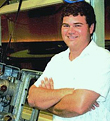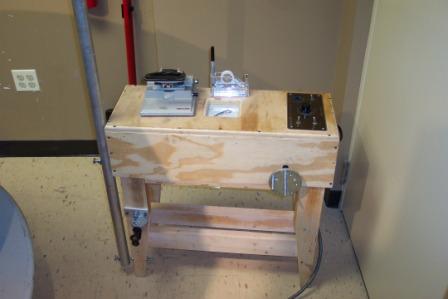|
|
This topic comprises 3 pages: 1 2 3
|
|
Author
|
Topic: Sidewinder -- double MUT
|
|
|
|
|
|
|
|
|
|
|
|
|
|
|
|
|
|
|
|
|
|
|
Michael Moore
Expert Film Handler

Posts: 188
From: Dover, DE / USA
Registered: Jun 2006
|
 posted 07-19-2007 12:08 AM
posted 07-19-2007 12:08 AM





good question Steve. When I build I take the pin out that grabs the reel. It just screws out. The reel can spin freely so there is very very low tension on the film, I do not put prints together at break neck speeds, rather i go slow, so I can control the speed of the free moving reel. The film never touches the ground. I know what you mean by the tension, and I had adjusted the resistor, but I just did not like the results. I went with the free spinning idea because it was the best solution at the time, and I have gotten so use to putting movies on the platter with it I have seen no need to change it. Now for break down, everything runs well, however there is more tension on the film then I really like so I take it very slow as well. I did not mean for this to get on the topic of the frankenMUT, but it turned out that way for a bit. As for Frankenreels they are coming next. As soon as I get done with FrankenGoldy
Mike
| IP: Logged
|
|
|
|
Michael Moore
Expert Film Handler

Posts: 188
From: Dover, DE / USA
Registered: Jun 2006
|
 posted 07-19-2007 07:20 AM
posted 07-19-2007 07:20 AM





You know I can see you doing that, but it will not be a very efficient way and you would lose most of your motor efficiency as heat at the amp side. DC controls (PWM) ramp up the voltage as the load is increased, trust me it is the only way to go. You could use a full wave Bridge rectifier and filter it with some caps, and then get a large (greater then 20 AMP) variac, and then a dancer arm to control the variac. Problem again is if any load is put on the DC motor at a fast rate you will stand a chance of destroying the motor due to over heating.
If I were going to make a transport (if that is what you want to do.) I would get two DC motors, to PWM controllers, and fabricate some dancer arms that will turn some small pots. The electronics from the PWM controller will do everything for you.
Plus if you are going to use it for film transport heat would not be an issue, just make sure the control boards are vented and that is all, you could even use some cheap computer fans to keep them cool if you wanted to.
Then all you would need to do is design your transport assay, Trust me I have experimented with DC motors more then I would like to share. I have designed drive circuits for all of my Machine shop tools, lathe milling machine, Drill press. etc. And the DC motor PWM is the most efficient, reliable and powerful for the money.
The best option for these kinds of tools are VFD drive circuits with 3 phase motors, but they cost too much. But they beat a rotary inverter any day for three phase.
Mike
![[Smile]](smile.gif)
| IP: Logged
|
|
|
|
|
|
All times are Central (GMT -6:00)
|
This topic comprises 3 pages: 1 2 3
|
Powered by Infopop Corporation
UBB.classicTM
6.3.1.2
The Film-Tech Forums are designed for various members related to the cinema industry to express their opinions, viewpoints and testimonials on various products, services and events based upon speculation, personal knowledge and factual information through use, therefore all views represented here allow no liability upon the publishers of this web site and the owners of said views assume no liability for any ill will resulting from these postings. The posts made here are for educational as well as entertainment purposes and as such anyone viewing this portion of the website must accept these views as statements of the author of that opinion
and agrees to release the authors from any and all liability.
|

 Home
Home
 Products
Products
 Store
Store
 Forum
Forum
 Warehouse
Warehouse
 Contact Us
Contact Us




 Printer-friendly view of this topic
Printer-friendly view of this topic





![[Frown]](frown.gif)





![[Razz]](tongue.gif)



![[Smile]](smile.gif)



